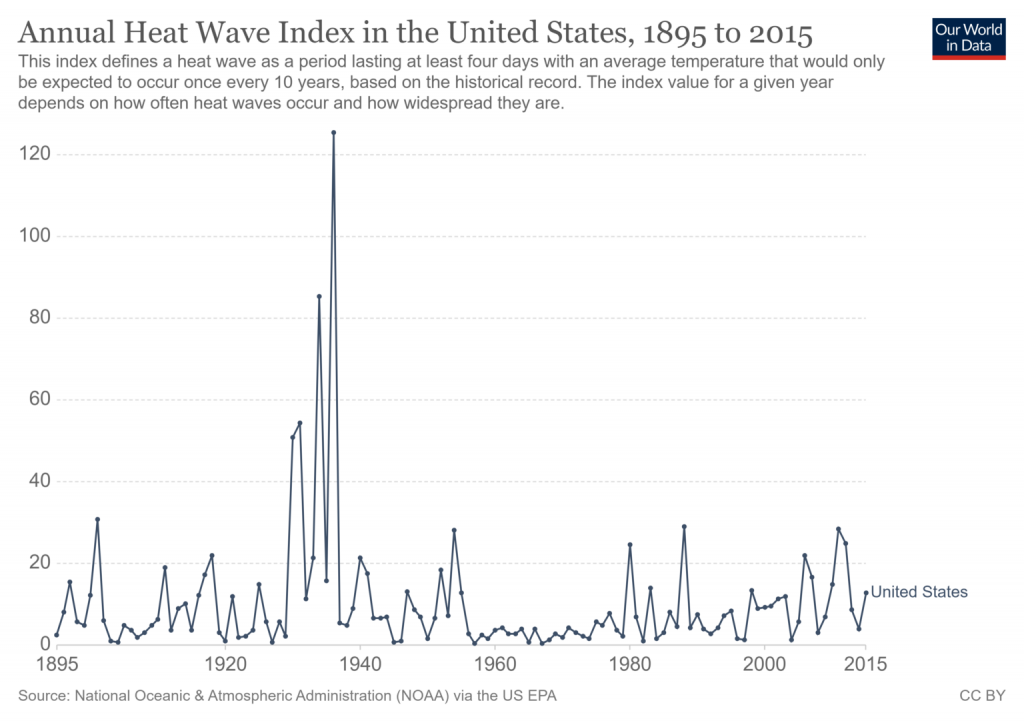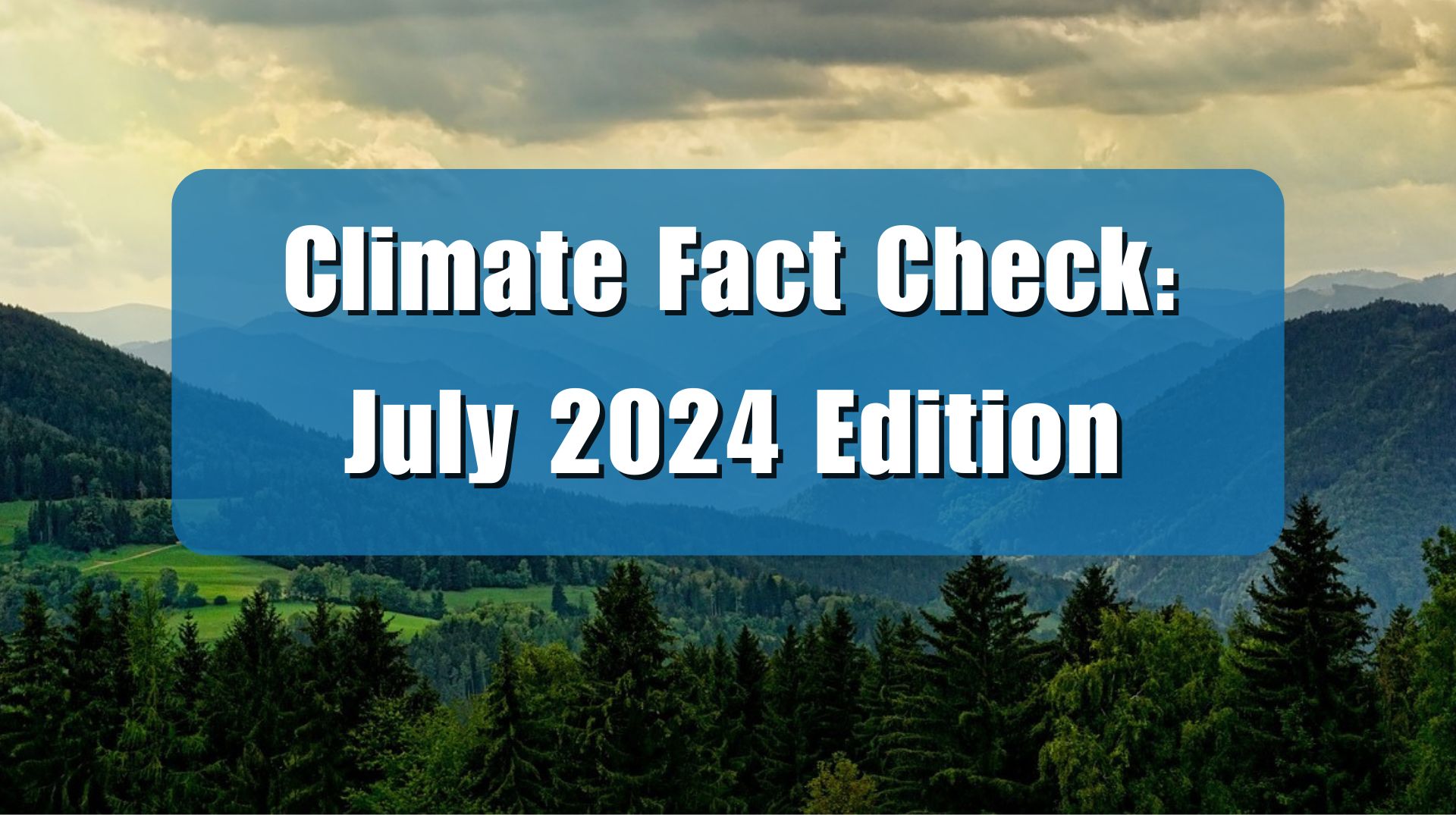Today’s Google search for the term “climate change,” turned up this whopper of a story put out by CBS News, “Wildfires and weather extremes: It’s not coincidence, it’s climate change,” claiming
“Right on the heels of arguably the West Coast’s most intense heat wave in modern history comes the most ferocious flare-up of catastrophic wildfires in recent memory … the recent uptick in the ferocity and frequency of these extremes, scientists say, is evidence of an acceleration of climate impacts….”
CBS is wrong on all counts. There has been no recent uptick in weather extremes, nor are current heatwaves, droughts or wildfires the most severe in modern history, unless you don’t count the late 19th and early 20th century’s as part of modern history.
Data show the number and severity of heat waves, droughts, and wildfires have all decreased over the past 150 years, even as the planet has modestly warmed.

As summarized in Climate at a Glance: Heat Waves, data from the U.S. Climate Reference Network and the National Oceanic and Atmospheric Administration prove climate change has not increased the number or severity of heat waves. Indeed, in recent decades heatwaves have been far less frequent and severe, for example, than in the 1930s (See the Figure 1 above). In fact, 40 states’ record-high temperatures were set before 1960, with 25 of the record highs being set or tied in the 1930s alone. The most accurate nationwide temperature station network, implemented in 2005, shows no sustained increase in daily high temperatures in the United States since at least 2005.
Nor did CBS tell the truth when it claimed,
“[i]n mid-August the West suffered through an extended heat wave which saw Death Valley surge to 130 degrees, the hottest temperature ever reliably measured on Earth.”
As meteorologist Anthony Watts pointed out in a Climate Realism article, “Media hypes 130°F Death Valley Temperature – but it’s still short of the 134°F record,” back in 1913, over 100 years of “global warming” ago, Death Valley’s official weather station at Greenland Ranch hit an all-time record of 134°F, topping 130°F or higher three times in July of 2013 alone.
CBS gets the facts wrong concerning droughts and wildfires, as well – there has been a downward trend during the past century.
While CBS claims “the West has entered into one of the worst megadroughts in the past 1,200 years,” data from the from the National Integrated Drought Information System (NIDIS) cited in Climate at a Glance: Drought shows droughts have declined recently, with the United States undergoing its longest period in recorded history without at least 40 percent of the country experiencing “very dry” conditions. Severe periods of drought occurred around 1978, 1954, 1930, and 1900, with each of those droughts being significantly more severe than what the United States has experienced in the 21st century and the late 20th century. Indeed, in 2017 and 2019, the United States registered its smallest percentage of land area experiencing drought in recorded history.
And the U.N. Intergovernmental Panel on Climate Change (IPCC) reports with “high confidence” precipitation over mid-latitude land areas of the Northern Hemisphere (including the United States) has increased during the past 70 years, while IPCC has “low confidence” about any negative trends globally.
Regarding wildfires, since drought is the key contributing climate factor, one should not be surprised to find, as reported in Climate at a Glance: Wildfires, records from the U.S. National Interagency Fire Center (NIFC) show wildfires have declined in number and severity in recent decades. The NIFC tracks data on U.S. wildfires back as far as 1926, and its shows the numbers of acres burned is far less now than it was throughout the early 20th century. As the Figure 2 below shows, current acres burned run about 1/4th to 1/5th of the record values which occurred in the 1930s.

Graph by meteorologist Anthony Watts
Globally, the data on wildfires is just as clear. On page 67 of Bjorn Lomborg’s book False Alarm, he points to research demonstrating:
“There is plenty of evidence for a reduction in the level of devastation caused by fire, with satellites showing a 25 percent reduction globally in burned area just over the past 18 years
…
In total, the global amount of area burned as declined by more than 540,000 square miles, from 1.9 million square miles in the early part of last century to 1.4 million square miles today.”
No matter which type weather extreme one wishes to examine, the evidence shows they have become less severe and frequent since the early 20th century. CBS should do a little research before publishing stories that get basic weather facts so wrong.

















[…] Jeff Beradelli on how wildfires and extreme weather are worsened by global warming, Heartland trotted out the usual cherry-picked denials at their new-ish climate realism website where they link to a mainstream media outlet’s climate […]
[…] Beradelli on how wildfires and excessive climate are worsened by international warming, Heartland trotted out the usual cherry-picked denials at their new-ish local weather realism web site the place they hyperlink to a mainstream media […]
[…] Beradelli on how wildfires and excessive climate are worsened by international warming, Heartland trotted out the usual cherry-picked denials at their new-ish local weather realism web site the place they hyperlink to a mainstream media […]
[…] Beradelli on how wildfires and excessive climate are worsened by international warming, Heartland trotted out the usual cherry-picked denials at their new-ish local weather realism web site the place they hyperlink to a mainstream media […]
[…] Jeff Beradelli on how wildfires and excessive climate are worsened by world warming, Heartland trotted out the usual cherry-picked denials at their new-ish local weather realism web site the place they hyperlink to a mainstream media […]
[…] Jeff Beradelli on how wildfires and extreme weather are worsened by global warming, Heartland trotted out the usual cherry-picked denials at their new-ish climate realism website where they link to a mainstream media outlet’s climate […]
[…] Beradelli on how wildfires and excessive climate are worsened by international warming, Heartland trotted out the usual cherry-picked denials at their new-ish local weather realism web site the place they hyperlink to a mainstream media […]
[…] Jeff Beradelli on how wildfires and excessive climate are worsened by world warming, Heartland trotted out the usual cherry-picked denials at their new-ish local weather realism web site the place they hyperlink to a mainstream media […]
[…] Jeff Beradelli on how wildfires and excessive climate are worsened by world warming, Heartland trotted out the same old cherry-picked denials at their new-ish local weather realism web site the place they hyperlink to a mainstream media […]
[…] Jeff Beradelli on how wildfires and extreme weather are worsened by global warming, Heartland trotted out the usual cherry-picked denials at their new-ish climate realism website where they link to a mainstream media outlet’s climate […]
[…] Jeff Beradelli on how wildfires and extreme weather are worsened by global warming, Heartland trotted out the usual cherry-picked denials at their new-ish climate realism website where they link to a mainstream media outlet’s climate […]
[…] Jeff Beradelli on how wildfires and extreme weather are worsened by global warming, Heartland trotted out the usual cherry-picked denials at their new-ish climate realism website where they link to a mainstream media outlet’s climate […]
[…] Jeff Beradelli on how wildfires and excessive climate are worsened by world warming, Heartland trotted out the usual cherry-picked denials at their new-ish local weather realism web site the place they hyperlink to a mainstream media […]
[…] Beradelli on how wildfires and excessive climate are worsened by international warming, Heartland trotted out the same old cherry-picked denials at their new-ish local weather realism web site the place they hyperlink to a mainstream media […]
[…] Beradelli on how wildfires and excessive climate are worsened by international warming, Heartland trotted out the usual cherry-picked denials at their new-ish local weather realism web site the place they hyperlink to a mainstream media […]
[…] Jeff Beradelli on how wildfires and extreme weather are worsened by global warming, Heartland trotted out the usual cherry-picked denials at their new-ish climate realism website where they link to a mainstream media outlet’s climate […]
[…] Beradelli on how wildfires and excessive climate are worsened by international warming, Heartland trotted out the usual cherry-picked denials at their new-ish local weather realism web site the place they hyperlink to a mainstream media […]
[…] Sterling Burnett of ClimateRealism writes that most of what is being said about climate and extreme weather is […]